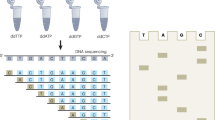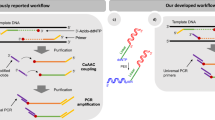Abstract
Advances in solid–phase oligonucleotide synthesis and hybridization techniques have led to an incipient technology based on the use of oligonucleotide arrays. The inclusion of a large number of oligonucleotide probes within a single array greatly reduces the cost of their synthesis and allows thousands of hybridizations to be carried out simultaneously. The range of potential applications of oligonucleotide arrays was expanded by the realization that nucleic acids can be sequenced by hybridizing them to all possible oligonucleotides of a given length. Additional possibilities are offered by novel types of oligonucleotide arrays that are capable of parallel sorting, isolating, and manipulating thousands, and even millions, of nucleic acid species. Fields, such as site–directed mutagenesis, protein engineering, and recombinant DNA technology, would benefit from using these arrays. Further, these approaches could enable the analysis of entire genomes by preparing ordered fragment libraries, and by sequencing complex pools of nucleic acids, in a novel approach that provides long–range sequence information by generating nested nucleic acids and then surveying the oigonucleotides contained in the nested strands. This would allow large diploid genomes to be sequenced directly in a completely automated procedure that does not require fragment cloning or chromosome mapping.
This is a preview of subscription content, access via your institution
Access options
Subscribe to this journal
Receive 12 print issues and online access
$209.00 per year
only $17.42 per issue
Buy this article
- Purchase on Springer Link
- Instant access to full article PDF
Prices may be subject to local taxes which are calculated during checkout
Similar content being viewed by others
References
Wallace, R.B., Shaffer, J., Murphy, R.F., Bonner, J., Hirose, T. and Itakura, K. 1979. Hybridization of synthetic oligodeoxyribonucleotides to φX174 DNA: the effect of single base pair mismatch. Nucleic Acids Res. 6: 3543–3557.
Sanger, F., Nicklen, S. and Coulson, A.R. 1977. DNA sequencing with chain-terminating inhibitors. Proc. Natl. Acad. Sci. USA 74: 5463–5467.
Maxam, A.M. and Gilbert, W. 1977. A new method for sequencing DNA. Proc. Natl. Acad. Sci. USA 74: 560–564.
Saiki, R.K., Walsh, P.S., Levenson, C.H. and Erlich, H.A. 1989. Genetic analysis of amplified DNA with immobilized sequence-specific oligonucleotide probes. Proc. Natl. Acad. Sci. USA 86: 6230–6234.
Conner, B.J., Reyes, A.A., Morin, C., Itakura, K., Teplitz, R.L. and Wallace, R.B. 1983. Detection of sickle cell βs-globin allele by hybridization with synthetic oligonucleotides. Proc. Natl. Acad. Sci. USA 80: 278–282.
Zhang, Y., Coyne, M.Y., Will, S.G., Levenson, C.H. and Kawasaki, E.S. 1991. Single-base mutational analysis of cancer and genetic diseases using membrane bound modified oligonucleotides. Nucleic Acids Res. 19: 3929–3933.
Landry, M.L. and Fong, C.K. 1985. Nucleic acid hybridization in the diagnosis of viral infections. Clin. Lab. Med. 5: 513–529.
Salyers, A.A. and Kuritza, A.P. 1990. DNA probes for identification of Bacteroides species. US patent 4,977,251.
Miyada, C.G. and Wallace, R.B. 1987. Oligonucleotide hybridization techniques. Meth. Enzymol. 154: 94–107.
Hoheisel, J.D. and Lehrach, H. 1993. Use of reference libraries and hybridisation fingerprinting for relational genome analysis. FEBS Lett. 325: 118–122.
Craig, A.G., Nizetic, D., Hoheisel, J.D., Zehetner, G. and Lehrach, H. 1990. Ordering of cosmid clones covering the herpes simplex virus type I (HSV-I) genome: a test for fingerprinting by hybridisation. Nucleic Acids Res. 18: 2653–2660.
Landegren, U., Kaiser, R., Sanders, J. and Hood, L. 1988. A ligase-mediated gene detection technique. Science 241: 1077–1080.
Wu, D.Y., Ugozzoli, L., Pal, B.K. and Wallace, R.B. 1989. Allele-specinc enzymatic amplification of β-globin genomic DNA for diagnosis of sickle cell anemia. Proc. Natl. Acad. Sci. USA 86: 2757–2760.
Broude, N., Sano, T., Smith, C. and Cantor, C.R. 1994. Enhanced DNA sequencing by hybridization. Proc. Natl. Acad. Sci. USA 91: 3072–3076.
Southern, E.M. 1989. Analysing polynucleotide sequences. PCT Application WO 89/10977.
Fodor, S.P., Read, J.L., Pirrung, M.C., Stryer, L., Lu, A.T. and Solas, D., 1991. Light-directed, spatially addressable parallel chemical synthesis. Science 251: 767–773.
Coassin, P.J., Rampal, J.B. and Matson, R.S. 1993. The construction of oligonucleotide arrays. International Workshop on Sequencing by Hybridization (Woodlands, TX): Report 8.
Pease, A.C., Solas, D., Sullivan, E.J., Cronin, M.T., Holmes, C.P. and Fodor, S.P.A. 1994. Light-generated oligonucleotide arrays for rapid DNA sequence analysis. Proc. Natl. Acad. Sci. USA 91: 5022–5026.
Fodor, S.P.A., Rava, R.P., Huang, X.C., Pease, A.C., Holmes, C.P. and Adams, C.L. 1993. Multiplexed biochemical assays with biological chips. Nature 364: 555–556.
Wood, W.I., Gitschier, J., Lasky, L. and Lawn, R.M. 1985. Base Composition-independent hybridization in tetramethyiammonium chloride: a method for oligonucleotide screening of highly complex gene libraries. Proc. Natl. Acad. Sci. USA 82: 1585–1588.
Maskos, U. and Southern, E.M. 1992. Parallel analysis of oligodeoxyribonucleotide (oligonucleotide) interactions. I. Analysis of factors influencing oligonucleotide duplex formation. Nucleic Acids Res. 20: 1675–1678.
Khrapko, K.R., Lysov Yu, P., Khorlin, A.A., Shik, V.V., Florentiev, V.L. and Mirzabekov, A.D. 1989. An oligonucleotide hybridization approach to DNA sequencing. FEBS Lett. 256: 118–122.
Khrapko, K.R., Lysov Yu, P., Khorlin, A.A., Ivanov, I.B., Yershov, G.M., Vasilenko, S.K., Florentiev, V.L. and Mirzabekov, A.D. 1991. A method for DNA sequencing by hybridization with oligonucleotide matrix. DNA Sequence 1: 375–388.
Maskos, U. and Southern, E.M. 1993. A novel method for the parallel analysis of multiple mutations in multiple samples. Nucleic Acids Res. 21: 2269–2270.
Southern, E.M., Maskos, U. and Elder, J.K. 1992. Analyzing and comparing nucleic acid sequences by hybridization to arrays of oligonucleotides: evaluation using experimental models. Genomics 13: 1008–1017.
Bains, W. and Smith, G. 1988. A novel method for nucleic acid sequence determination. J. Theor. Biol. 135: 303–307.
Drmanac, R., Labat, I., Brukner, I. and Crkvenjakov, R. 1989. Sequencing of megabase plus DNA by hybridization: theory of the method. Genomics 4: 114–128.
Lysov Yu, P., Florentiev, V.L., Khorlin, A.A., Khrapko, K.R., Shik, V.V. and Mirzabekov, A.D. 1988. Determination of the nucleotide sequence of DNA using hybridization to oligonucleotides. A new method. Dokl. Akad. Nauk SSSR 303: 1508–1511.
Strezoska, Z., Paunesku, T., Radosavljevic, D., Labat, I., Drmanac, R. and Crkvenjakov, R. 1991. DNA sequencing by hybridization: 100 bases read by a non-gel-based method. Proc. Natl. Acad. Sci. USA 88: 10089–10093.
Drmanac, R., Drmanac, S., Strezoska, Z., Paunesku, T., Labat, I., Zeremski, M., Snoddy, J., Funkhouser, W.K., Koop, B., Hood, L. and Crkvernjakov, R. 1993. DNA sequence determination by hybridization: a strategy for efficient large-scale sequencing. Science 260: 1649–1652.
Pevzner, P.A., Lysov Yu, P., Khrapko, K.R., Belyavsky, A.V., Florentiev, V.L. and Mirzabekov, A.D. 1991. Improved chips for sequencing by hybridization. J. Biomol. Struct. Dyn. 9: 399–410.
Bains, W. 1991. Hybridization methods for DNA sequencing. Genomics 11: 294–301.
Pevzner, P.A. 1989. L-tuple DNA sequencing: computer analysis. J. Biomol. Struct. Dyn. 7: 63–73.
Chetverin, A.B. and Kramer, F.R. 1992. Novel oligonucleotide arrays and their use for sorting, isolating, sequencing, and manipulating nucleic acids. US Patent Application 07/838,607.
Drmanac, R., Petrovic, N., Glišin, V. and Crkvenjakov, R. 1986. A calculation of fragment length obtainable from human DNA with 78 restriction enzymes: an aid for cloning and mapping. Nucleic Acids Res. 14: 4691–4692.
Wu, D.Y., Nozari, G., Schold, M., Conner, B.J. and Wallace, R.B. 1989. Direct analysis of single nucleotide variation in human DNA and RNA using in situ dot hybridization. DNA 8: 135–142.
Arnheim, N. and Erlich, H. 1992. Polymerase chain reaction strategy. Annu. Rev Biochem. 61: 131–156.
Myers, T.W. and Gelfand, D.H. 1991. Reverse transcription and DNA amplification by a Thermus thermophilus DNA Polymerase. Biochemistry 30: 7661–7666.
Williams, J.G. 1981. The preparation and screening of a cDNA clone bank. p. 1–59. In: Genetic Engineering, Volume 1. Williamson, R. (Ed.). Academic Press, London.
Chetverin, A.B. and Kramer, F.R. 1993. Sequencing of pools of nucleic acids on oligonucleotide arrays. BioSystems 30: 215–231.
Gyllensten, U.B. and Erlich, H.A. 1988. Generation of single-stranded DNA by the polymerase chain reaction and its application to direct sequencing of the HLA-DQA locus. Proc. Natl. Acad. Sci. USA 85: 7652–7656.
Jeffreys, A.J. 1979. DNA sequence variants of the Gγ-, Aγ-, δ- and β-globin genes of man. Cell 18: 1–10.
Rubinov, A.R., Gelfand, M.S., Ivanov, M.Y., Spirin, S.A., Razgulyaev, O.I., Nakipov, R.F. and Chetverin, A.B. 1993. Computer modeling of sequencing by nested strand hybridization. International Workshop on Sequencing by Hybridization (Woodlands, TX): Report 35.
Author information
Authors and Affiliations
Rights and permissions
About this article
Cite this article
Chetverin, A., Kramer, F. Oligonucleotide Arrays: New Concepts and Possibilities. Nat Biotechnol 12, 1093–1099 (1994). https://doi.org/10.1038/nbt1194-1093
Issue Date:
DOI: https://doi.org/10.1038/nbt1194-1093
This article is cited by
-
Genetics in child and adolescent psychiatry: methodological advances and conceptual issues
European Child & Adolescent Psychiatry (2015)
-
Genetic testing: The problems and the promise
Nature Biotechnology (1997)
-
Scanning of nucleic acids by in vitro amplification: New developments and applications
Nature Biotechnology (1996)
-
DNA fingerprinting techniques for microorganisms
Molecular Biotechnology (1996)



